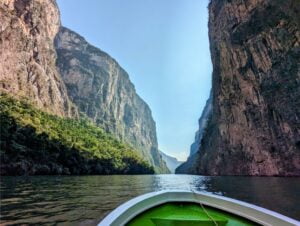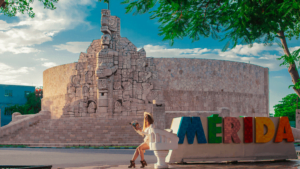
Making a Migratory Stopover in Palenque (Mexico)
Hello everyone!
As suggested in our last post, the past week has been super busy with travel-related activities. And now that we finally have some time to breathe, we wanted to catch everyone up with what has been going on. But that is going to take at least two posts!
We enjoyed our time in Merida, Mexico: wonderful people, fantastic winter weather, convenient day-to-day slow-travel living, and many interesting and inexpensive ways to pass the time. We’re not exactly city people at heart, but we admit that we could see ourselves setting up an occasional home base here, at least during the coldest 4 months of the year.
But now that our two scheduled months in Merida were finally over, it was time to close shop and move on to our next home base – San Cristobal de las Casas.
Unfortunately, San Cristobal de las Casas is a LONG 15-hour bus ride away from Merida!
Thankfully there was one more Maya archeological zone we wanted to visit, and it was at the halfway point on our route to San Cristobal de las Casas: the ancient city of Palenque. So instead of killing ourselves with an ultra-long migration, we planned a shorter trip to the town of Palenque and used it as a base for a couple of nights to explore the nearby archaeological zone.
Why Visit Palenque?
The ancient city of Palenque in the state of Chiapas, Mexico, was among the most powerful Maya cities in the Classic Period of Maya civilization (250 AD – 900 AD). While its Maya name was believed to be “Lakamah”, meaning big water, Palenque was named after the neighboring Spanish town Santo Domingo Palenque, founded in the 16th century. The Maya city of Palenque was once an important political center, which flourished between 226 and 799 AD and was later abandoned around 900 AD.
The surrounding jungle overtook the city, which lay buried and hidden until the 1700s when local Maya told a Spanish priest of its existence. It wasn’t until the 20th century, however, that it was excavated and opened to the public.
An interesting feature about Palenque is that the hieroglyphs found there have informed scholars about hundreds of years of Maya history. They describe alliances, trade, exchange, wars, and even marriage between Maya cities.
In 1952, archeologist Albert Ruz Lhuillier removed a stone from the back room of the Temple of the Inscriptions and found a passageway, which led down to the tomb of Palenque’s famous emperor Pakal the Great. Emperor Pakal lived for about 80 years and was extremely tall, both of which were very uncommon for Maya at the time. His tomb was covered with an ornately carved lid and was buried wearing an elaborate jade death mask.
In summary, Palenque provides a disproportionate amount of information about Maya history compared to other excavated sites in Mexico. Its importance to the field of Mesoamerican history and archaeology cannot be overstated.
Getting From Merida to Palenque
When traveling from city to city in Mexico, we prefer to use the first-class ADO buses. It is usually far cheaper than local budget airlines and makes the most sense for us since we have an abundance of time. That, and it is really easy to book tickets in advance online.
So at 8:30 am on Wednesday, January 3rd we hopped on a bus that left from the ADO Centro Historico bus station in Merida for Palenque. Tickets cost $803 MXN ($46.92 USD) each.
The route went through several different towns (and four Mexican states), taking about 9 hours.
We arrived in Palenque (in the Mexican state of Chiapas) at about 5:30 pm with sore posteriors, but otherwise no worse for wear.
We hired an overpriced taxi from the bus station ($70 MEX/$4.11 USD) that took us to the apartment that we booked on Booking.com for two nights: Departamentos Reina Roja.
It was pretty cheap at $28.12 USD per night, considering it was equipped with AC, had a solid kitchen, a TV, bathroom, dining room table/chair setup, and twin bed. It was about 50% cheaper than the next cheapest private room + private bathroom option on Booking.com.
Afterward, we grabbed a local dinner in town and headed back to our apartment to rest up for the evening. We planned on visiting the Palanque Archaeological Zone the next morning.
Getting to the Palenque Archaeological Zone
Like with our trip to Chichen Itza, this was easy. We took a collectivo!
The departure point for the Palenque Ruins collectivo was easy to find in town, using Google Maps:

We arrived at the collectivo at around 7:30 am and departed once the van was full. The going rate for a one-way trip to the ruins is $25 MEX ($1.47 USD) per person, despite what Google Maps says.
The ride took about 15 minutes and the driver dropped us off at the Palenque Archaeological Zone ticketing area.
Entering the Palenque Archaeological Zone
We arrived at about 7:45 am. The park wasn’t open quite yet, so we waited in line. And for once, we were first!
At 8 am sharp, the ticket windows were open for business.
The process for buying tickets was the same as with other archaeological zones we visited while living in Merida. As usual, there were two ticket booths, one for a general admission fee and one specific to the Chiapas Government. The general admission fee was $95 MEX ($5.58 USD) per person. However, the Chiapas Government admission fee was only $109 MEX ($6.40 USD) per person for foreigners.
Credit cards are allowed for the general admission fee, BUT NOT for the Chiapas Government entrance fee (CASH ONLY)!
In total, we paid only $408 MEX ($23.94 USD) for both of us to get in.
This was SIGNIFICANTLY less expensive than all of the other Maya sites we visited, due to the Chiapas Government entrance fee being FAR cheaper than the Yucatan Government entrance fee.
Drunk on the affordability of this visit, we did something that in hindsight was probably unwise – we hired a tour guide.
We managed to haggle a complete full site tour for two at the Spanish-language rate of $1,500 MEX. And by complete I mean that it allowed access to the deeper jungle areas of the archaeological zone you can only see with a guide. After adding on our $200 MEX tip at the end, the total cost for our guide was $1,700 MEX ($99.75 USD).
We saved quite a bit of money compared to their normal rates, although it may not seem like it!
Our guide was interesting and we did learn a lot of historical facts in context as we walked through the site. But that said, we probably would have been better off just reading up about the site history before arrival and saving our money.
Lesson learned. Sometimes we need to remind ourselves why we usually don’t book tour guides.
Exploring the Palenque Archaeological Zone
When we finally entered the site at around 8:20 am, we almost had the place to ourselves. But we knew that would change since Palenque is the big tourist draw in the area. So there was a slow, gradual increase in tourist density by the time we left at 1:30 pm, but nothing like what we saw at Chichen Itza.
The excavated area of the Palenque Archaeological Zone seemed about as large as the Uxmal Archaeological Zone, but smaller than Chichen Itza for sure. But Palenque has a more well-established network of trails through the jungle to less well-excavated areas, so it took us quite a while to explore everything.
And as with the Uxmal Archaeological Zone, we explored the main excavated area twice!
Here are some of our favorite photos. For detailed descriptions of many of the major structures, CLICK HERE.

















Impressions of the Archaeological Zone
We had a great visit!
The cheap entry fee and diversity of things you can see (archaeological and outdoorsy) make coming to the Palenque Archaeological Zone a no-brainer if you are in the area.
Sadly, the Palenque Archaeological Zone museum, which is said to feature several significant archaeological finds, was closed for renovation for the next three months. They are sprucing it up for the impending Maya Rail extension to Palenque, which is very close to coming online. When the Maya Rail is finally active in these parts, there will be MANY more tourists coming to see Palenque, for better or worse.
So that was a bummer, but what can you do? Thankfully, many of Palenque’s greatest archaeological hits are on display at museums in Mexico City, so we’ll have to wait until April to see those.
A Final Hurrah in Town
We took the same collectivo back to the town of Palenque, where we visited the town center, and got some refreshments.

We then went back to our place to recover for a few hours before dinner. We needed a break! But eventually, the need for a real meal summoned us back to town.

By the end of the dinner, we put in a lot of miles and were pretty exhausted!
Afterward, we headed back to our apartment to crash. We had a 7:45 am bus to San Cristobal de las Casas the next morning, and it would be another 9-hour butt-numbathon.
But that is a story for another time.
Until then…
Thanks for reading!
Leave a comment below and subscribe to get email notifications whenever we post!
Follow Two Travel Turtles on Facebook and Twitter!
























4 thoughts on “Making a Migratory Stopover in Palenque (Mexico)”
Amazing!!
We think so too!
Palenque looks amazing…what a great site!!
We really enjoyed it!